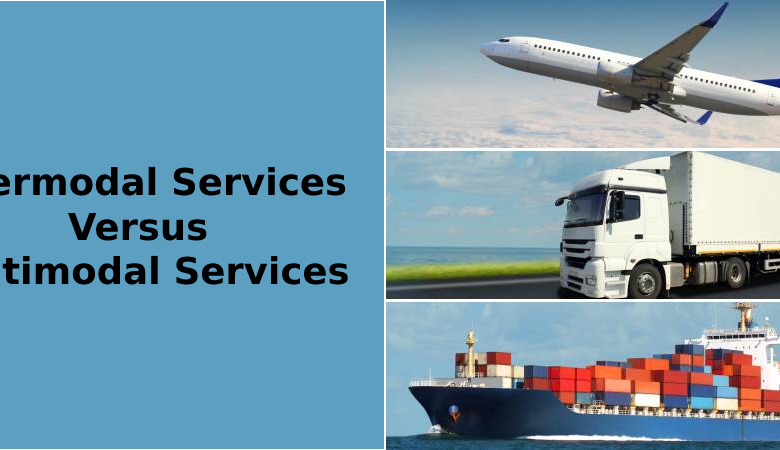Intermodal Services Versus Multimodal Services – What’s the Difference and Which One Should You Select?

Transportation plays a major role in every industry. It is a means to carry goods or people from one place to another. Besides, there are several different modes of transportation—i.e., intermodal, multimodal, etc. Choosing the right mode of transportation becomes necessary as it helps to increase efficiency and reduce the operational cost.
Let us understand what intermodal transport is and what multimodal transportation is.
What Is Intermodal transport?
As the name itself implies- intermodal services are a way of transportation in which more than one mode of transportation is being used. Under this mode of transportation, freight is transferred in an intermodal vehicle or a container where the Intermodal Agents keep changing at every leg of transport.
Book Airport Transfers – The State of the Art Services
How Does Intermodal Transport Work?
As mentioned above, in intermodal transport, more than one transportation mode is used to move freight from one place to another. In intermodal services, each part of the shipment is contracted with the different transport service provider.
Let’s take an example. Suppose you want to move cargo from Florida to New Jersey. How will you transfer the goods? If you choose a truck mode only, it will be too costly. Therefore, it is necessary that you choose more than one mode of transportation.
For example, for the first leg of the transport, you can choose the truck. Later, the truck will carry the freight to the rail yard. From the rail yard, the container will reach the seaport via train. From the harbor, the cargo will reach the rail yard via ship near the destination.
From the rail yard, the container will again pick up and transported to the destination via truck. And this is how the journey of a consignment from Florida to New Jersey will complete.
Take note that, all the legs of shipment transfer is handled by the different intermodal services provider. Each contractor has a responsibility to deliver the consignment to the next contractor successfully.
How CFO Services Can Drive Growth For Small Businesses
Advantages of Intermodal transport
The benefits of intermodal services include:
1) Lower Operational Cost:
Keeping the operational cost lower is a necessary part of every shipment. In Intermodal services, carriers can take advantage of lower rates, and the flexibility of choosing the different transport medium, which reduces handling costs.
2) Environmental Friendly:
Using the intermodal mode of transport, shippers can help the environment too. In this mode, you can significantly reduce the carbon footprint by choosing various ways. A study reveals that trucks emit approximately 19.8 pounds of carbon dioxide per 100 ton-miles, while the trains only emit about 5.4 pounds.
3) Reliable and safe:
intermodal transport is also safe and secure. As the shipments pass through many hands, there are multiple checks of the consignments. This will ensure reliability.
Best SEO Company Melbourne Offer SEO Services to Small Businesses
What Is Multimodal Transportation?
Multimodal transport is very much similar to intermodal transport. Just like intermodal transport, multimodal transport also carried with at least two different modes of transport. But unlike intermodal services, in multimodal services, the goods is transferred under a single contract. The carrier is liable for the entire transit.
Operating Amid COVID-19? 6-Step Guide for Restaurants And Food Services
How Does Multimodal Transportation Work?
Let us understand the working of multimodal transport by taking a real-life example. Suppose you want to transfer the goods from Florida to Los Angeles. Here, you can choose two modes of transportation- either by truck or by ship. Or, there could be a mixture of both, i.e., multimodal transport.
Here, you can choose by road transportation for the first leg of the journey. Once the consignments reach the port, you can select the shipping mode. Again when the shipment reaches the Los Angeles land, you can opt for truck transport. But if the destination is far from the Los Angeles port, you can choose rail mode first and then the truck.
You may have noticed that the entire journey of the shipment is much similar to intermodal services. Then how are they different from each other?
As mentioned above, the only significant difference between intermodal transport and multimodal transport is, in multimodal, the intermodal trucking company remains the same for the entire transport even though it is operated by different modes of transportation.
Things to check out before booking airport taxi services in London
Advantages of Multimodal Transportation
1) Less Transfer Time:
Being a single contractor based transportation, it coordinates well at every interchange. This method will save time and resources.
2) Faster Transit:
Multimodal transport is also a quicker mode than intermodal transport. As the contractor knows the things well in advance, he/she can manage the things accordingly if the need arises to ensure the unobstructed transfer of goods.
3) Secure:
As there is only one company and contractor involved in the whole transit, we can certainly ensure the safety of the goods.
Conclusion:
As we understood, both the intermodal and multimodal transport are almost similar expect the number of contractors. If time and safety is more of your concern, you should choose multimodal transportation, and if Cost is your point of interest, go with intermodal transport.




